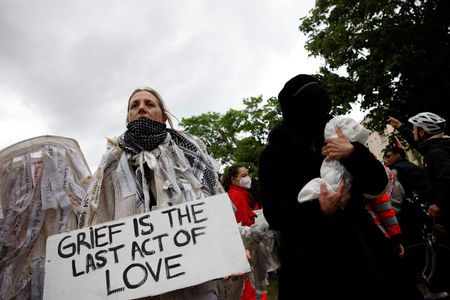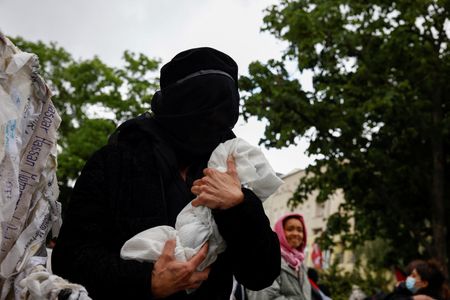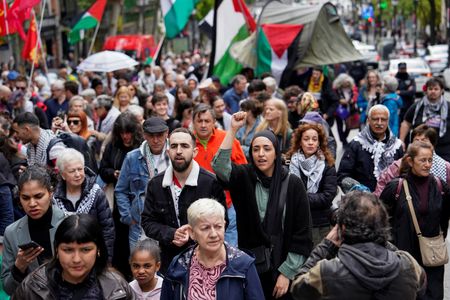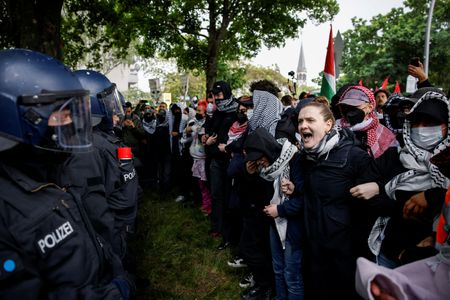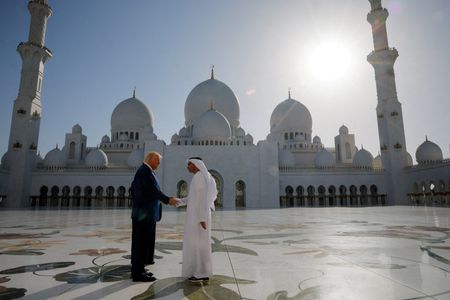By Hussam al-Masri and James Mackenzie
GAZA/JERUSALEM (Reuters) – Palestinians marked Nakba day on Thursday, commemorating the loss of their land after the 1948 war at the birth of the state of Israel, as Israeli military operations in Gaza and the occupied West Bank have again displaced hundreds of thousands.
The Nakba, or “catastrophe”, has been one of the defining experiences for Palestinians for more than 75 years, helping to shape their national identity and casting its shadow on their conflicted relationship with Israel ever since.
The resonance has been amplified by the war in Gaza and the Israeli army’s months-long campaign in West Bank refugee camps, where hundreds of thousands of descendants of Palestinians who lost their homes in 1948 have lived for decades.
The war has destroyed large swathes of Gaza and forced most of the more than 2 million people who live there to move multiple times, clinging on in tents or bombed-out houses and other makeshift shelters.
“During all the wars that there have been, there has been nothing like what happened during this war,” said Badryeh Mohareb, who lived through the Nakba as a child, when her family fled their home in the seaside city of Jaffa, near Tel Aviv to come to Gaza.
The May 15 Nakba day commemoration marks the start of the 1948 war, when neighbouring Arab states attacked Israel a day after the new state declared its independence following the withdrawal of British forces from what was then called Palestine.
The fighting lasted for months and cost thousands of lives, with more than 700,000 Palestinians fleeing their homes or driven away from villages in what is now Israel, most into makeshift camps like the ones now occupied by the displaced of Gaza.
Sitting in front of the ruins of her house in the southern city of Khan Younis, where she moved after she was married, she said two of her grandchildren had been killed and everything she had was lost.
“People are destroyed,” she said.
Israel’s campaign in Gaza, launched in retaliation for the devastating Hamas attack on southern Israel on October 7, 2023 has been one of the longest, and certainly the most bloody in its history, leaving much of the Gaza Strip barely habitable.
Hardliners in the government, encouraged by U.S. President Donald Trump’s plan for a Gaza emptied of its Palestinian population and converted into a beachside resort, have spoken openly about seizing the entire enclave.
After a two-month truce, Israel resumed its operation in Gaza in March, squeezing the population into an ever-narrowing area against the coast and in the area around Khan Younis as its forces have pressed in from the border zones.
According to the UN humanitarian agency OCHA, 70% of Gaza is now within the no-go areas set up along the edges of the enclave or in areas under displacement orders by the military and more than 436,000 people have been displaced since March.
WEST BANK
In the West Bank too, Palestinians have been facing growing pressure as Israeli settler violence and the military operations in northern cities like Jenin and Tulkarm have forced tens of thousands from their homes.
“I only took two outfits with me, hoping that it would last for two, three or four days,” said Mustafa Abu Awwad, an 88-year-old Palestinian, as he described his hurried departure from the Nur Shams refugee camp near Tulkarm in January.
“I move from one area to another… every week or 10 days we move from place to another.”
The military moved into the area in January, in a large-scale operation it said was aimed at rooting out militant groups that had become entrenched in refugee camps that have developed into crowded urban townships.
The military has remained ever since, in the longest operation the West Bank has seen since the second Intifada uprising two decades ago, systematically destroying houses, roads and infrastructure.
According to United Nations figures more than 40,000 people in the West Bank have been displaced since the start of the operation, a situation OCHA says could amount to forcible transfer, defined as a crime against humanity by the International Criminal Court.
Stripped of their inhabitants, the camps in Jenin and Tulkarm have been reduced to ghost towns with no functioning power, water or other infrastructure, making it increasingly difficult for anyone to return.
(Additional reporting by Raneen Sawafta; Editing by Alexandra Hudson)

